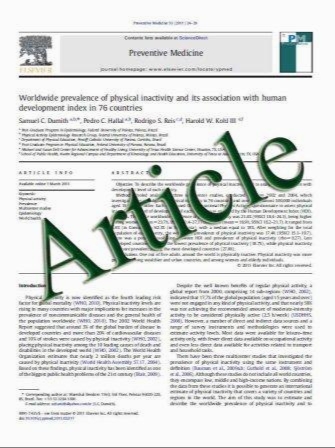Assessing joint involvement in haemophilia by clinical rheumatologic scores. A pilot study on similarities with subjects with psoriatic arthritis
- نوع فایل : کتاب
- زبان : انگلیسی
- مؤلف : Matteo Nicola Dario Di Minno & Salvatore Iervolino & Rosario Peluso & Antonio del Puente & Anna Russolillo & Antonio Coppola & Carlo Ruosi & Anna Guid
- چاپ و سال / کشور: 2011
Description
Because of joint haemorrhages, severe haemophilia subjects often have limitations in their daily activities. Current orthopaedic scores (OJS) in haemophilia miss mild joint impairments and only pick up severe alterations. Twelve young severe haemophiliacs (20.25± 1.9 years of age), were evaluated for OJS as well as for indices employed in rheumatoid arthritis [28-joint Disease Activity Score (DAS-28), Ritchie index, Health Assessment Questionnaire (HAQ), visual analogue scale (VAS)], spondyloarthritis [Bath Ankylosing Spondylitis Disease Activity Index (BASDAI), HAQ, VAS] and osteoarthritis [Knee injury and Osteoarthritis Outcome Score (KOOS), VAS]. Twentyfour matched apparently healthy subjects and 29 subjects with psoriatic arthritis (PsA) with oligoarticular involvement (one to three swollen joints) served as controls. In addition to the impairment of target joints (elbow, in five of five in those ondemand treatment; three, elbows; four, knee in those on secondary prophylaxis), HAQ (mean 0.71±0.95) and VAS (3.12±2.36) documented a quality of life and a perception of pain in haemophiliacs similar to that of PsAsubjects (p=0.061 and p=0.063, respectively). Their Ritchie index did not differ from that of subjects with psoriatic arthritis (5.75±8.1 vs 7.73±9.22; p=0.408), nor did the BASDAI score with respect to psoriatic arthritis patients (p=0.105). Six of 12 haemophiliacs (50%) had KOOS values from 70 to 50 (significant function joint impairment); 3 of 12 (25%) showed DAS-28 values >3.2 (moderate disease activity), 2 of 12 (16.6%) severe disease activity (>5.1). All these indices significantly correlated with VAS and HAQ in haemophilia subjects. A rheumatologic assessment may help identify early polyarticular disease and subclinical abnormalities involving joints not usually studied (not target joint) in haemophiliacs. These pilot data provide the rationale for testing a systemic involvement in haemophiliacs by means of high-tech imaging and to start early-onset prophylaxis/ treatment in this setting.
Clin Rheumatol (2011) 30:915–919 Received: 12 August 2010 / Revised: 19 January 2011 / Accepted: 31 January 2011 / Published online: 16 February 2011


